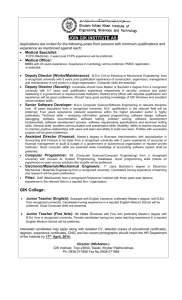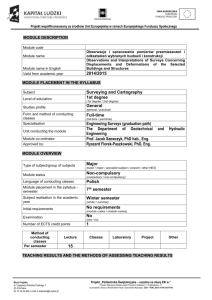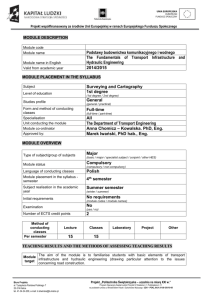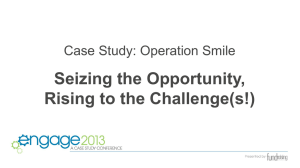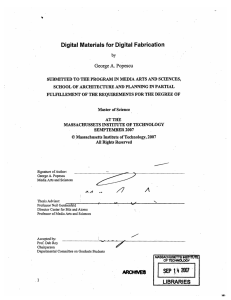New Guidance on Accounting for GIK
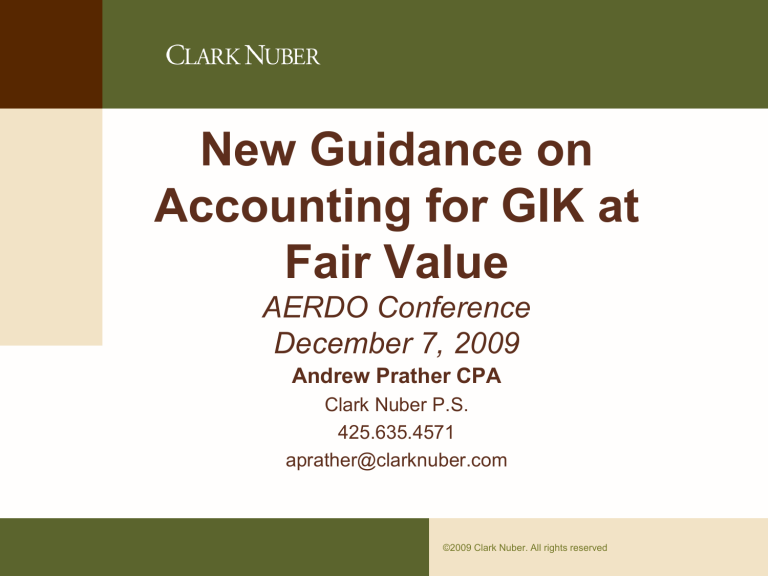
New Guidance on
Accounting for GIK at
Fair Value
AERDO Conference
December 7, 2009
Andrew Prather CPA
Clark Nuber P.S.
425.635.4571
aprather@clarknuber.com
©2009 Clark Nuber. All rights reserved Page 0
Background
• Contributions, including GIK, are required to be recorded at fair value
• Previously , no consistent standard on how fair value should be determined
• New accounting guidance has been issued that establishes how fair value should be determined for accounting and financial reporting
Page 1
Fair Value Measurements (SFAS 157)
• Who: FASB, establishes U.S. GAAP
• What: New accounting standard issued fair value measurements
• When: Effective for periods beginning after 11/15/08 (year-ends 12/2009,
6/2010) for transactions like GIK
• Why: Establishes principles-based framework for fair value measurements
Page 2
Definition of Fair Value
• Fair value is the price that would be received to sell an asset or paid to transfer a liability in an orderly transaction between market participants at the measurement date.
Page 3
Definition of Fair Value
• Fair value is the price that would be received to sell an asset or paid to transfer a liability in an orderly transaction between market participants at the measurement date.
Page 4
The Price
• Fair value is the price that would be received to sell an asset … in an orderly transaction between market participants at the measurement date.
• “Exit price” concept
• FV = “What could your organization sell this
GIK for?”
• The price should not be adjusted for transaction costs
Page 5
The Asset
• Fair value is the price that would be received to sell an asset … in an orderly transaction between market participants at the measurement date.
• FV is specific to the GIK you are valuing; therefore must consider attributes specific to that GIK
– Condition and/or location of the GIK
– Restrictions, if any, on the sale or use of the GIK
– Volume of GIK received in the donation
Page 6
The Asset
• FV assumes the highest and best use of the
GIK by the market participants that is physically possible, legally permissible, and financial feasible. In other word, the use that would maximize the economic value of the
GIK to the market participants.
Page 7
The Asset
• GIK-specific guidance:
– Need to determine whether any restrictions on sale or use are entity-specific restrictions or asset-specific restrictions
• Entity-specific restrictions don’t impact FV
• Asset-specific restrictions do impact FV
• IRC 170(e)(3) restrictions are considered to be entityspecific restrictions and don’t impact FV
– Highest and best use
• Economic not charitable
• Generally will be the sale of the GIK in a commercial market
Page 8
Orderly Transaction
• Fair value is the price that would be received to sell an asset … in an orderly transaction between market participants at the measurement date.
• FV assumes the GIK would be sold in an orderly transaction, not a forced or rushed sale
Page 9
Market Participants
• Fair value is the price that would be received to sell an asset … in an orderly transaction between
market participants at the measurement date.
• FV determined based on how market participants would value the GIK
Page 10
Market Participants
• Market participants are buyers in the principal (or most advantageous) market for the GIK that are:
– Independent of the reporting entity
– Knowledgeable
– Able to transact for the GIK
– Willing to transact for the GIK
Page 11
Market Participants
• GIK-specific guidance:
– Beneficiaries generally are not market participants
– Market participants are those entities who would transact for the GIK and are able to buy the GIK from your organization
– Because of the nature of GIK you may need to create a hypothetical scenario to identify who the market participants are
– They may include other NGOs, governmental agencies, or commercial entities, depending on the
GIK
Page 12
Principal (or Most Advantageous)
Market
• FV assumes the GIK is sold in the principal market, or most advantageous market if no principal market exists
• Must be the market that your organization has access to
• The principal market is the one that has the greatest volume and level of activity for that GIK
• The most advantageous market is the market that maximizes the price to be received
• Must use the principal market if one exists
Page 13
Principal (or Most Advantageous)
Market
• GIK specific guidance:
– Most organizations will consider 3 markets:
• Beneficiaries market: Often the principal market, but usually beneficiaries are not able to transact for the GIK and so they are not market participants, and therefore the beneficiaries market cannot be considered in the FV
• Donative market: Groups with donative intent that provide
GIK; usually cannot be used because these are contribution transactions and not exchange tranactions
• Commercial market: This is the only market with reciprocal transactions; only market relevant for determining FV
Page 14
Definition of Fair Value
• Fair value is the price that would be received to sell an asset in an orderly transaction between market participants at the measurement date.
Page 15
Valuation Techniques
• Possible valuation techniques:
– Market approach – Uses prices and other relevant information generated by market transactions involving identical or comparable assets
– Income approach – Converts future amounts such as cash flow or earnings to a single present amount.
– Cost approach – Current replacement cost of the assets (i.e. the cost to acquire or construct a substitute asset)
Page 16
Valuation Techniques
• Possible valuation techniques:
– Market approach – Uses prices and other relevant information generated by market transactions involving identical or comparable assets
– Income approach – Converts future amounts such as cash flow or earnings to a single present amount.
– Cost approach – Current replacement cost of the assets (i.e. the cost to acquire or construct a substitute asset)
Page 17
Inputs to Valuation
• Observable vs. unobservable inputs –
– Observable – data from sources independent of your organization
– Unobservable – internally generated data
• Maximize the use of observable inputs
Page 18
Inputs to Valuation
• Levels of inputs
– Level 1 – Quoted prices (unadjusted) in active markets for identical assets
– Level 2 – Quoted prices for similar assets or liabilities in active or inactive markets
– Level 3 – Management’s assumptions about the assumptions market participants would utilize
• Give highest priority to level 1, and lowest to level 3
Page 19
Inputs to Valuation
• GIK-specific guidance:
– Level 1 inputs usually not available for GIK
– Level 2 inputs would include prices for pharmaceuticals listed in the Red Book or baseball cards as listed in Beckett magazine
– Level 3 inputs would include prices developed by a donor based upon the donor’s perceived market value of the contribution
– GIK typically uses Level 2 or 3
Page 20
In Summary . . .
• SFAS 157 is a principles-based standard,
• Requires organizations to use judgment in determining fair value for specific transactions
• Can result in different organizations assigning different fair values to the same type of GIK
• . . . but there should likely be less variability than pre-SFAS 157
Page 21

